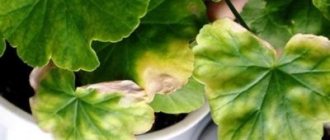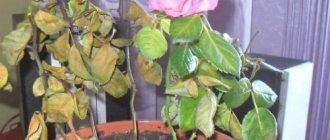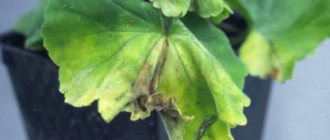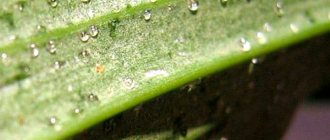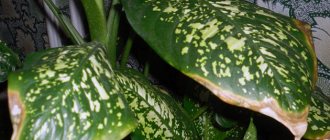There are many plants living in homes and offices. Each variety and type of indoor flowers has its fans. Some people love roses and ficus trees, while others like modest geraniums. When caring for home plantings, novice and experienced gardeners face various problems. Houseplants, instead of delighting with lush greenery and abundant flowering, begin to wither, become sick, and their leaves become dull and dry. Why the leaves of indoor flowers turn yellow - what to do in this case is described in this article.
Causes of yellowing leaves and ways to solve the problem
When the leaves of indoor plants turn yellow, before doing anything, you need to figure out the reasons. Every problem has its solution. The situation with yellowed leaves is aggravated by the fact that there are many reasons leading to such a sad result. Most often they require a comprehensive solution.
Cyclamen is one of the most interesting indoor plants
It is possible to restore the lost color of green leaves only after identifying the cause of yellowing and getting rid of it. Risk factors for why indoor flowers turn yellow are divided into two large groups:
- Violation of plant agrotechnics. These reasons are the most common. Especially for beginner gardeners. A change in leaf color is the plant’s very first reaction to improper care. Of course, each flower requires an individual approach. But since they are all kept in houses, the solutions for different types are often the same.
- Pests and diseases. They are dangerous because they can spread from one infected plant to others. Affected specimens must be urgently treated or, if the disease is incurable, destroyed.
Yellowed leaves
Below we discuss in detail the various causes of yellowing foliage and how to eliminate them.
Reason 2. Drafts and sudden temperature changes
If you have no problems with watering, pay attention to the placement of the flower. Perhaps he is standing under an open window, under an air conditioner, a fan, or leaning against an icy window glass. Such situations often lead to yellowing and subsequent blanching of the leaves. This problem can also be caused by too hot air from radiators and heaters.
How to provide plants with the correct temperature conditions
Indoor flowers are very sensitive to temperature changes, so the best thing to do is to find a warm place for them without active air currents. If this is not possible, simply move the flowers deeper into the room while airing. Also, if necessary, insulate window cracks and place pots on wooden stands.
Never place indoor plants on a working heater; try to keep them away from window sills under which heating radiators are located. Ideally, there will be at least 15-20 cm from the heat source to the pot.
It is especially difficult for flowers in winter, when the risk of temperature changes is especially high, so pay more attention to your pets.
Dry air as a cause of yellowing
Why do daylily leaves turn yellow - what to do
Dry air is a winter problem. Dried by central heating radiators, it draws moisture from the leaves. Plants with thin, delicate leaves are the first to suffer. They turn yellow and dry out.
Attention! Maintaining optimal humidity is the key to good health and active flowering of indoor plants.
You can humidify the air with special household appliances and using devices made from scrap materials.
The problem can be solved by regular spraying, although this method is not suitable for plants with pubescent leaves, as well as begonias and some other species. A good option might be a container of water or wet expanded clay placed next to the pots.
Lack or excess moisture
Often the tips of the leaves turn yellow simply because the plant does not receive moisture. They turn yellow, dry out, and may even fall off, but you just need to adjust the watering. The problem may be hidden in heavy compacted soil, which does not allow water to pass to the roots; after watering, only a few centimeters of the top layer are moistened, which of course does not nourish the plant. It is advisable to check the depth of water penetration with your finger and do not forget to replant your plants.
The edges of the leaves may turn yellow and dry out due to dry air; spraying or simply an open vessel with clean water nearby will help solve the problem.
What often surprises inexperienced gardeners is that leaves can also turn yellow due to excess moisture. Most plants prefer a normal amount of moisture, its excess can lead to rotting of the roots or simply displacement of air, and this will have a bad effect on its overall health; the leaves will simply be the first to report this. If this happens, you need to immediately start replanting, at the same time carefully examine the roots, assess the damage caused and take action.
Insufficient watering
Why do rhododendron leaves turn yellow and what to do?
Yellowing of the tips of the leaves is a sure sign that the plant needs moisture. Even with regular watering and a substrate that is damp to the touch, it may happen that the roots do not receive enough water.
Using untreated water for irrigation can also cause yellowed leaves. Hard, unsettled tap water will cause plants to yellow and wilt.
Watering is carried out until water begins to appear in the pan. If the soil is very dry, you can water the flower by immersing the pot 2/3 in water for a while, allowing the water to saturate the entire lump.
Is it possible to remove such leaves?
One of the important points in the situation with yellowed and drying leaves is their removal .
How to remove leaves from an orchid? During the period of replanting an orchid, this question usually does not arise, since almost all damaged, dried and non-viable parts of the plant must be removed.
In a situation where it is too early to replant, you should carefully consider the process of removing the drying leaf. First of all, you need to check the drying phase.
If the leaf is not completely dry, it should not be removed, as it continues to nourish the plant. Only after complete drying and strictly according to the rules - it is removed carefully, trying not to damage the delicate trunk.
Drying of the leaf surface occurs unevenly and can continue for quite a long time; it is necessary to wait until they are completely dry.
Lack of lighting
Why do indoor balsam leaves turn yellow?
With a lack of light, the foliage of indoor flowers loses color unevenly, and often even falls off. This type of leaf fall is typical for hibiscus.
Attention! If the leaves turn yellow on only one side of the plant, this is a clear sign of lack of lighting.
Flowers will turn yellow if the pots are too far from the light source, or on window sills oriented north, northwest.
Light-loving plants especially suffer from a lack of sunlight. The lack of natural lighting is easily compensated for by artificial lighting. A lamp with a fluorescent lamp is suitable. Such lighting does not overheat the flower and consumes minimal energy.
Sometimes you can solve the problem by turning the yellowed part of the plant towards the light.
Why do the tips and edges of leaves on indoor plants turn yellow?
Many of us love to surround ourselves with indoor flowers in our home. It is also difficult to imagine a summer cottage without vegetation - shrubs, trees, flowers and vegetables. It is very common to observe how the tips and edges of leaves of many plants begin to turn yellow for unknown reasons.
Growing plants is a difficult and labor-intensive task. It requires certain knowledge and investment of labor and time. Beginning gardeners often encounter the problem of yellowed leaves.
Why do plants turn yellow? This may be due to improper care of flowers. In fact, yellowing of leaves occurs for various reasons. We will talk about them in our article.
Lack of fertilizers and nutrients in the soil
The lack of nutrients in the soil affects the metabolic processes of the plant. A deficiency of a particular substance can be determined by specific signs:
Feeding is important for indoor plants
- Nitrogen. A macronutrient, indoor flowers that grow for a long time in the same substrate suffer from its deficiency. The foliage becomes pale green or yellow, becomes smaller and withers.
- Calcium deficiency is determined by a specific yellowing of the tips of leaf blades.
- Magnesium. Its deficiency can be determined by small spots between the veins, which increase in size over time. If magnesium does not reach the plant at all, then the yellow color of the leaves turns into orange and red.
- Copper deficiency is similar to magnesium deficiency, but the symptoms include leaf wilting.
- A lack of manganese will result in leaves turning gray-yellow or yellow-green. This color will appear on the leaves of a plant planted in a substrate with a strong alkaline reaction.
- Molybdenum. The edges and areas between the veins turn yellow, while the leaves and petals curl - a signal of molybdenum starvation.
The problem of lack of nutrients in the soil is solved quite simply. The application of complex fertilizers, preferably containing elements in chelated form, will restore the greenness of flowers. When feeding, it is worth taking into account the characteristics of the plant and the phases of its life cycle. During active growth, the flower needs nitrogen, and during the flowering period - potassium and phosphorus.
Experienced gardeners advise using mineral fertilizers, as they are easier to dose and eliminate the risk of introducing parasites and diseases.
Important! It is worth considering that simply replanting a plant into better soil may be more beneficial for it than a series of fertilizing.
Be sure to feed
Fertilizer application can vary greatly among different plant species.
This may be reflected in the content of nutrients included in the formulation, dosage and frequency of application required. For example, the cause of yellowing of flower leaves will be both a deficiency of nutrients and their excess.
As a rule, it begins in the upper part of the plant and gradually appears in the form of yellowish spots on the plates along the veins.
Competent maintenance and careful care are the main helpers in preventing various causes of yellowing of the leaves of indoor plants. All that is required from the owner of a green ward is to examine it in time, so that when the first alarming symptoms appear, they can correctly determine the cause and take the necessary measures to improve the health of the plant.
Disadvantages of temperature conditions
Indoor plants, unlike garden plants, are not adapted to winds and drafts.
- Drafts
If the leaves of a plant standing under an air conditioner or near an open window turn yellow, then it is enough to change its place of residence.
- Sudden temperature changes
Temperature changes, both downward and upward, can cause stress for the plant.
- Cold surfaces
In cold winters, foliage in contact with window glass may turn yellow. In this case, there is a danger of the plant dying from hypothermia.
Yellow leaves need to be removed and the flower moved away from the glass.
Have a pest inspection
A significant cause of yellowing of leaves in plants is considered to be damage by diseases and parasites. A similar phenomenon is observed both with fungal diseases of indoor flowers, for example, late blight, fusarium or anthracnose, and as a result of damage by parasites.
Among such “indoor” pests are aphids, spider mites, whitefly larvae, mealybugs or thrips. If the plant is nevertheless attacked by pests, it is necessary to promptly carry out a primary set of procedures at home:
- It is necessary to isolate the plant from other pets to avoid infection with parasites.
- Treat the leaves with soapy water.
- Try to increase the air humidity (this is due to the fact that insects most often appear in dry, stagnant air).
- Apply insecticides (you can find such preparations in any flower shop).
- In case of damage by soil pests, transplant the plant into a thoroughly disinfected pot, making sure to replace the soil.
- Carry out preventive procedures for the remaining plants. It is necessary to carefully treat not only the flowers themselves, but also the place where they are kept.
Pot for indoor flower
An unsuitable pot can cause plant disease.
- In an overly large pot, moisture stagnates and the roots rot.
- If it is very small, the substrate dries out quickly, the root system does not develop, and there are few nutrients there.
A tree growing in a tiny pot is doomed to fall leaves even with the best care.
Important! You definitely need high-quality drainage from expanded clay and broken clay pots.
Errors in soil selection will affect the condition of the pet. The use of universal primer is unacceptable. Each species requires a special soil composition.
Excess of microelements in feeding
Orchids are very sensitive plants and react negatively not only to a lack of nutrition , but also to an excess of it. It is especially dangerous to overfeed a plant at the beginning of its development. In most cases, flower growers purchase flowering orchids from retailers.
For more lush and vibrant flowering, unscrupulous sellers overfeed the plants with fertilizers and all kinds of stimulants. After 2-3 years, such orchids are completely depleted and die.
Therefore, experienced orchidists recommend not feeding newly purchased orchids throughout the quarantine and even longer. Sometimes it is worth replanting the orhu in a new container with a new substrate.
A common problem when feeding is an excess of calcium , which causes rapid salinization of the soil, which makes it difficult or completely impossible for the plant to absorb iron.
The entire system of plant absorption of minerals is disrupted. The leaves turn pale, turn yellow at the tips, and curl. The edge of the sheet plates takes on a “ragged” appearance. It especially hits young leaves.
The fastest solution would be an emergency transplant with the roots soaked in distilled and running water.
Recommendation! During the recovery period, you should completely exclude nutrition with mineral complexes containing calcium.
Infectious diseases
An infection that appears on one flower can quickly spread to neighbors, so diseases must be promptly recognized and treated. Infections that lead to yellowing of foliage and methods of treating them are reflected in the table.
| Disease | Affected plants | Signs | Methods of treatment and prevention |
| Root rots of various origins | Orchids, succulents, cacti, Saintpaulias, Schefflera. | Wilting, yellowing of leaves, rot on the root collar. | Treatment: remove the plant from the pot, wash the roots, and treat with a fungicide. If the lesion is large, it is incurable. Prevention: breathable, light soil, adherence to the watering regime. |
| Cucumber mosaic | Begonias. | Yellow spots and rings. Leaves are deformed. | The disease is incurable. The plant must be destroyed, the pot and window sill must be disinfected. |
| Fusarium | Orchids, anthurium. | Rotting of roots and root collars, yellowing of leaves. | Treatment: practically incurable. The plant along with the soil must be destroyed. In the initial stages, replanting and treating with fungicides can help. Prevention: sterile instruments when cutting. |
| Plant jaundice | Callas, orchids, pelargoniums, primrose, begonia, poinsettia. | Yellow spots on leaves, wilting. | Treatment: practically incurable. The plant along with the soil must be destroyed. In the initial stages, replanting and treating with fungicides can help. Prevention: compliance with agricultural technology. |
| Late blight | Succulents, cacti, azaleas, orchids. | Necrotic spots of yellow or brown color, rotting of the base of the stem. |
Verticillium wilt
The causative agent is fungi of the genus Verticillium. It reproduces exclusively asexually - by conidia, affects plant roots and poisons xylem tissue: it grows and reproduces systemically throughout the plant.
Symptoms: at the initial stages of the disease, the lower leaves acquire a grayish-greenish color due to the development of interveinal necrosis. The leaf tissue between the veins turns brown and dries out. Then wilting begins, most of the leaves, starting from the bottom, turn yellow, curl and dry out. On a section of the stem, browning of the vessels is noticeable. The lumens of the vessels are filled with thin multicellular mycelium. Plants are stunted, develop poorly, and then die. Sometimes the disease manifests itself on the plant in the drying out and death of individual branches of the bush. If conditions are favorable, the disease spreads to other branches and the entire plant dies quite quickly. If conditions are unfavorable for the development of the fungus, the disease can drag on for months and part of the plant looks healthy, while part dies.
The pathogen persists in the soil in the form of microslerotia for several years. The optimal temperature for germination of sclerotia is 25-27°, humidity 60-70%. The fungus is most likely to develop on soil with a neutral pH value of 7-7.5. Fungal spores germinate and penetrate the conductive tissue, where mycelium develops, causing blockage of blood vessels. Since there is a gradual clogging of the vessels from the bottom up, the withering of the leaves begins with the lower leaves and gradually covers the entire plant.
Prevention
Do not use garden soil for indoor plants without pre-treatment: pour it onto a baking sheet in a 5 cm layer, heat it at maximum temperature for 20 minutes. Disinfect seeds by heating and disinfectants (for example, Maxim fungicide)
Control measures
Chemical agents, due to the unique biology of the pathogen (development in the soil and spread through conducting vessels), are ineffective. Treatment is possible only in the initial stages, by spraying with foundationazole, Vectra (3 ml per 10 liters of water) or topsin-M at a concentration of 0.2%.
Pests of indoor flowers
Parasites of domestic plants feed on cell sap, infecting leaves and stems. In addition to direct harm, insects and ticks carry viral and bacterial diseases, which often cannot be treated. The most common flower pests are:
| Pest | Description | Signs of appearance | Risk group | Fighting methods |
| Spider mite | Peak activity is winter and early spring, when the indoor air is dry. Belongs to arachnids. Common types: ordinary, cyclamen, red. | The leaves become dull, lose color, begin to fade, and cobwebs appear on the lower surface. | Hibiscus, ficus, dracaena, ivy, tradescantia, fuchsia, citrus. | 1. Warm shower. 2. Treatment with soap solution or garlic infusion. 3. For severe damage - acaricides, systemic insecticides |
| Aphid | Light green or yellowish insects, living in large colonies. | Unhealthy, curled leaves, damaged buds and growing points. | Plants with delicate foliage and shoots. Small-leaved species are especially vulnerable. | In the early stages, the plant is quarantined and treated with a strong soap solution. If there is a lot of pests, insecticides will help: Actellik, Aktara, Inta-vir and others. |
| Shchitovka | Insects from the scale insect family, the body is covered with a waxy shield, which makes it difficult to combat the pest. It is found on the inner surface of the leaf, in the area of the veins. | Yellow-brown spots along the leaf veins. Affected leaves lose color and wilt. | Ferns, asparagus, ivies, lemon, begonias. | Difficult to treat. A combination of mechanical cleaning and treatment with Aktara is effective. Females can only be destroyed mechanically. |
| Thrips | Sucking pests. The larval stage takes place inside the leaf; the flying adults are black and can quickly infect an entire collection of flowers. | The larval stage can be identified by light dots and streaks on the leaves. The leaf is deformed, its structure is disrupted, its color is lost, and it dies. | Palm trees, citrus fruits, hoya, monstera, laurel, syngonium, saintpaulia. | At the larval stage it is curable with systemic insecticides. |
| Root nematodes | The larvae live in the soil. Once in the roots, they develop there, forming growths that block the flow of water and mineral salts to the shoots. | Slow growth, yellow leaves, swelling on the roots. | Plants planted in contaminated soil are at risk. | 1. Disinfection of roots with a fungicide. 2. Substrate replacement. 3. In difficult cases, it is better to destroy the plant immediately |
Spider mite on a rose
Note! Folk remedies, such as treatment with soap solution, infusions, and so on, only help with the early stages of pest infestation.
Reason 5. Damage by pests and diseases
Many plant diseases can manifest themselves by yellowing of leaves. In apartment conditions, flowers are sometimes weakened by various unfavorable factors and become susceptible to such ailments as gray, white and root rot, bacterial spotting, etc. Often a problem arises if the soil in the pot is taken from the garden and has not been disinfected. In any case, until the causes are identified, immediately isolate the flower from other plants, remove damaged parts and treat with Fitosporin.
Pests may also be to blame for yellowing leaves. Spider mites, aphids, scale insects, thrips, mealybugs, nematodes suck juices from leaves and stems, disrupt the process of photosynthesis and often cause plant death.
At the first symptoms of pests, isolate the plant and spray it with a soap solution (30 g of soap per 1 liter of water). If possible, give him a warm shower, paying special attention to the lower parts of the leaves where insects hide. If pests are not visible from the outside, carefully dig up the flower and inspect the earthen ball. Larvae can live there and feed on the roots. To help the plant, clean the soil down to the roots, wash off the larvae and soak the roots in a pink solution of potassium permanganate. Then replant the flower in fresh, disinfected soil.
How to care for flowers so that the leaves don't turn yellow
The rule that it is easier to prevent a disease than to treat it also applies to caring for indoor plants.
Plants on the window
The main methods for preventing yellowing of leaves of domestic flowers include:
- Water the flowers only when the earthen ball is about half dry.
- Regular replanting of plants, change of soil.
- Carrying out fertilizing, while the dose is used slightly less than the instructions for the drug require.
- Providing a long photoperiod, excluding direct solar radiation. In winter you can use a phytolamp.
- Compliance with the temperature regime and the level of air humidity required for each type.
- Choosing a pot according to the size and age of the plant and the condition of the root system.
- Drainage is required.
- Eliminate drafts and cold air flows.
- Conducting weekly inspections of your collection of house plants, monitoring soil moisture, the appearance and condition of each flower, signs of pests and diseases.
Before ridding your pet of yellowing foliage, you need to evaluate the plant's life cycle. If this is not a natural course of events, then you can begin to implement rescue measures. Using the information provided, you need to find out the reasons for the wilting and then systematically restore your favorite flower.
Give the plant more sun
The abundance of sunlight is one of the most comfortable conditions for the existence and development of any flower.
Insufficient lighting can contribute to yellowing leaves in your pets. If you do not have the opportunity to move the pot to a brighter place, then try to provide lighting to the plant using phytolamps.
However, remember: excessive lighting is not always beneficial for plants, since yellowing spots are often the result of sunburn of the leaves.
In this case, the flowers should be arranged, trying to avoid direct sunlight. It is not necessary to hide them in shaded corners for these purposes. The problem can usually be solved by keeping curtains loosely closed, which can protect your plants during the hottest parts of the day.
Wrinkling and yellowing of the leaf blade
Loss of turgor with further yellowing has several reasons , some of which can even lead to the death of the plant. This:
- Overheat;
- Humidity;
- Excessive fertilization;
- Diseases.
First of all, we need to find the root cause of turgor loss , which is the main threat to wrinkling of the leaf surface that receives nutrition, participates in photosynthesis and promptly evaporates excess moisture.
If there is a loss of turgor in orchid leaves, it is necessary to identify the cause.
If the situation is not allowed to become critical, then the plant can be restored . It may even be worth sacrificing flowering for a while and transplanting the orchid into a new substrate, treating the root part from damage and disease.
How to adjust the feeding regime?
It is necessary to strictly approach the choice of fertilizers for such delicate and sensitive plants. Use only special complex fertilizers for orchids.
It is better to underfeed an orchid than to overfeed it.
Experienced orchid growers recommend reducing the concentration of fertilizing applied by 2-4 times from that indicated on the package. This will greatly help balance the process of additional nutrition and prevent an excess of macro- or microelements.
There is no special formula for the concentration and frequency of fertilizing. Each variety, like a single plant, requires an individual approach . Knowledge, recommendations from flower growers, personal experience and careful observation of the development of orchids will lead to the creation of a balanced and proper diet for exotic beauties.
Description and structure of the plant
Cyclamen is a herbaceous perennial plant with a hard, thickened root. The leaves of the plant are round or heart-shaped, dark green in color with interesting silver or white patterns.
The petals of flowers are bent back and can have a very diverse color. Cyclamens bloom from October to March with crimson red, pink and white, purple buds. The lifespan of one flower is about ten days.
Important! Cyclamen is a poisonous plant. Its tubers contain a substance that can cause irritation or inflammation of the skin.
Home care
- If the flower was purchased in a store, then it must be replanted.
- Cyclamen cannot be replanted during flowering.
- The flower pot should not be large.
- During flowering, feed weekly with complex mineral fertilizers. Cyclamen does not tolerate a lot of nitrogen fertilizers.
East or west windows are best suited for this indoor flower in summer, and south windows in winter.- Summer temperatures for this flower range from 18 to 22°C.
- To flower, cyclamen requires a temperature no higher than 16°C.
- Watering should be done moderately; overwatering can be harmful. When watering, do not pour water directly onto the tuber and shoots. Water only along the edge of the pot. An hour after watering, the remaining water must be drained from the pan so that rot does not appear on the roots. Read how to save flooded cyclamen here.
- At the end of flowering, cyclamens are watered less often, and in the summer, when the leaves begin to dry, even less.
Important! Flowers are more afraid of waterlogging than drying out.






